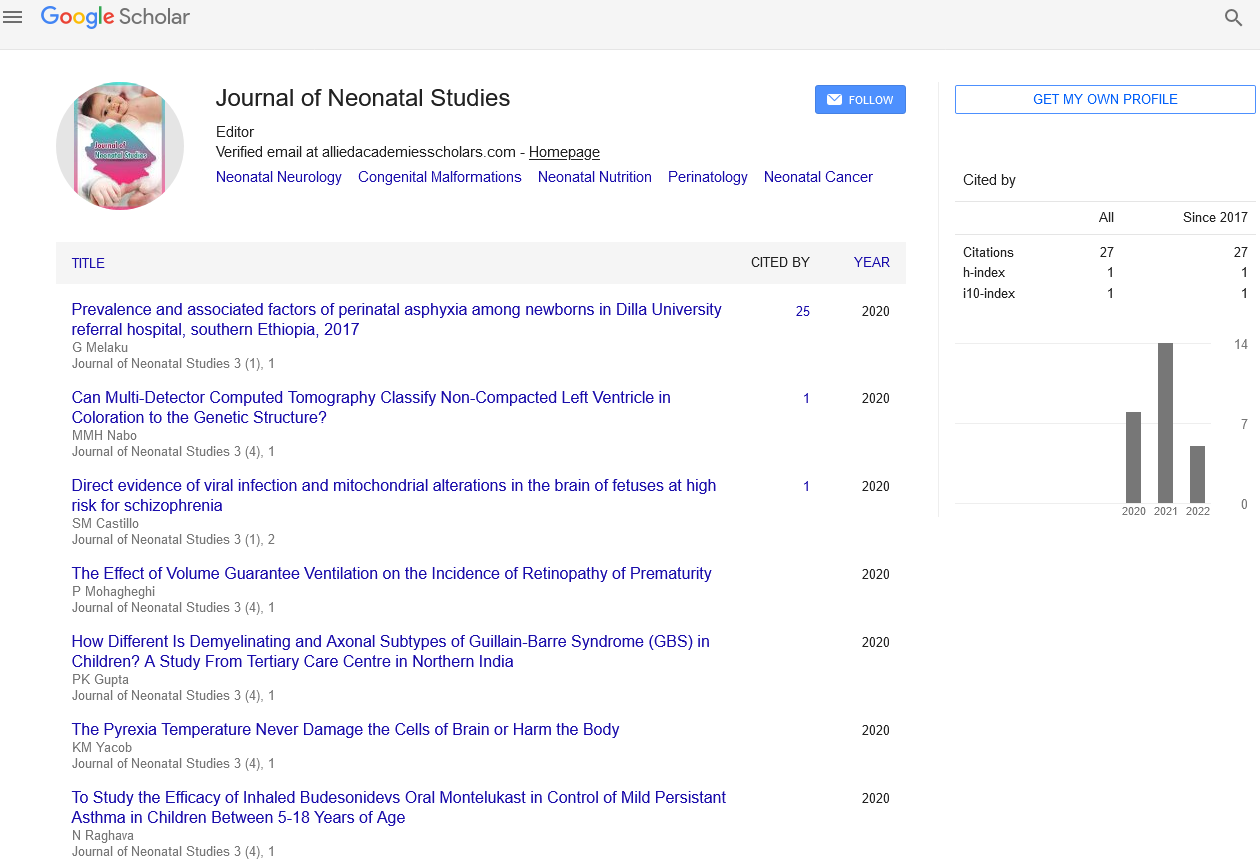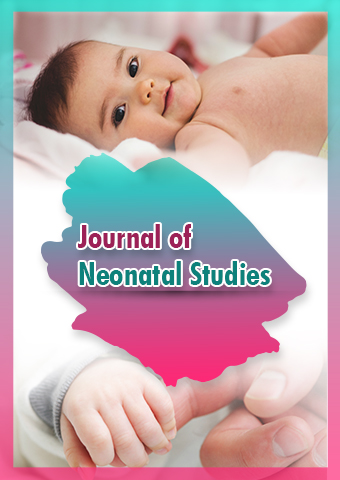Review Article - Journal of Neonatal Studies (2023) Volume 6, Issue 3
Neonatal Hypothermia: Understanding the Dangers and Importance of Temperature Control in Newborns
Liu Lei*
Key Laboratory for Biomedical Effects of Nano materials and Nano safety, Institute of High Energy Physics, Chinese Academy of Sciences, Beijing, China
Key Laboratory for Biomedical Effects of Nano materials and Nano safety, Institute of High Energy Physics, Chinese Academy of Sciences, Beijing, China
E-mail: leiliuqq23@ihep.edu.ac.cn
Received: 01-June-2023, Manuscript No. jns-23-104284; Editor assigned: 2-June-2023, PreQC No. jns-23- 104284(PQ); Reviewed: 15-June- 2023, QC No. jns-23-104284; Revised: 23-June-2023, Manuscript No. jns-23- 104284(R); Published: 30-June-2023; DOI: 10.37532/jns.2023.6(3).85-87
Abstract
Neonatal hypothermia is a critical condition characterized by low body temperature in newborn infants, posing significant risks to their health and well-being. The first hours and days of a newborn’s life are crucial for their development and adjustment to the outside world, making temperature regulation a vital aspect of neonatal care. This article aims to explore the dangers of neonatal hypothermia, its causes, consequences, prevention, and management strategies, highlighting the importance of maintaining optimal body temperature for the overall health of newborns.
Keywords
Neonatal hypothermia • Temperature • Infants • Birth • Oxygenation
Introduction
Impact of neonatal hypothermia
Neonatal hypothermia can have severe consequences on the health and survival of newborn infants. The immature thermoregulatory mechanisms in newborns make them more susceptible to rapid heat loss and difficulty in maintaining a stable body temperature. When the body temperature drops below the normal range (36.5-37.5 degrees Celsius or 97.7-99.5 degrees Fahrenheit), it can lead to various complications, including:
Respiratory distress
Hypothermia affects the respiratory system, causing shallow breathing, apnea (temporary cessation of breathing), and decreased oxygen saturation. It impairs the newborn’s ability to exchange gases effectively, leading to respiratory distress and the need for supplemental oxygen or respiratory support [1-5].
Metabolic instability
Neonatal hypothermia disrupts the infant’s metabolic balance. It impairs the body’s ability to produce and maintain energy, resulting in hypoglycemia (low blood sugar levels) and metabolic acidosis. These metabolic disturbances can impact organ function and compromise the overall well-being of the newborn.
Infection susceptibility
Hypothermic newborns are at a higher risk of developing infections. Cold stress weakens the immune system, making them more susceptible to bacterial, viral, and fungal infections. Infection further exacerbates the hypothermic state, creating a vicious cycle that can be life-threatening if not promptly addressed.
Discussion
Causes of neonatal hypothermia
Several factors contribute to the development of neonatal hypothermia such as
Environmental factors
The external environment plays a significant role in heat loss. Cold room temperature, drafts, inadequate insulation, and lack of appropriate clothing or blankets can contribute to heat dissipation and increase the risk of hypothermia.
Inadequate thermal protection at birth
During birth, immediate skin-to-skin contact and the use of warm, dry towels or blankets are essential for preventing hypothermia. Delayed drying and removal of wet clothing expose the newborn to evaporative cooling, further compromising temperature regulation [6,7].
Prematurity or low birth weight
Premature infants and those with low birth weight have less body fat and limited glycogen stores, which are crucial for thermoregulation. Their immature thermoregulatory mechanisms, such as brown fat production and shivering, are less efficient, making them more susceptible to hypothermia.
Prevention and management strategies
Preventing and managing neonatal hypothermia require a comprehensive approach, involving various interventions and strategies. Immediate skin-to-skin contact Initiating skin-to-skin contact between the newborn and the mother or caregiver immediately after birth promotes warmth and thermal regulation. Skin-to-skin contact provides warmth, encourages breastfeeding, stabilizes the newborn’s temperature, and facilitates bonding [8,9].
Warm delivery environment
Ensuring a warm delivery environment is crucial. Warm delivery rooms, radiant warmers, and preheated surfaces help maintain an appropriate ambient temperature during birth. Drying the newborn and covering them with a warm blanket immediately after delivery reduces heat loss [10].
Body temperature in newborns
Neonatal hypothermia, a condition characterized by a low body temperature in newborn infants, is a significant concern in healthcare settings worldwide. Maintaining optimal body temperature is crucial for newborns as they transition from the protected environment of the womb to the outside world.
This discussion aims to provide a comprehensive understanding of neonatal hypothermia, including its dangers, causes, prevention strategies, and management approaches. By addressing this critical issue, we can promote the health and well-being of newborns and reduce the associated risks.
Dangers of neonatal hypothermia
Neonatal hypothermia poses numerous dangers to the health and survival of newborn infants. The thermoregulatory system of a newborn is immature, making them vulnerable to rapid heat loss and difficulty in maintaining a stable body temperature. When the body temperature falls below the normal range (36.5-37.5 degrees Celsius or 97.7-99.5 degrees Fahrenheit), it can lead to several complications:
Respiratory distress
Hypothermia affects the respiratory system, resulting in shallow breathing, apnea (temporary cessation of breathing), and decreased oxygen saturation levels. The impaired gas exchange ability of the lungs contributes to respiratory distress, necessitating supplemental oxygen or respiratory support.
Metabolic instability
Neonatal hypothermia disrupts the infant’s metabolic balance. It impairs the body’s ability to produce and maintain energy, leading to hypoglycemia (low blood sugar levels) and metabolic acidosis. These metabolic disturbances can impact organ function and compromise the overall well-being of the newborn.
Infection susceptibility
Hypothermic newborns are more susceptible to infections. Cold stress weakens the immune system, making them prone to bacterial, viral, and fungal infections. Infections further worsen the hypothermic state, creating a dangerous cycle that can be life-threatening if not promptly addressed.
Conclusion
Causes of neonatal hypothermia
Several factors contribute to the development of neonatal hypothermia such as
Environmental factors
The external environment plays a significant role in heat loss. Cold room temperature, drafts, inadequate insulation, and insufficient clothing or blankets increase the risk of heat dissipation and hypothermia.
Inadequate thermal protection at birth
During birth, immediate skin-to-skin contact and drying the newborn with warm towels or blankets are crucial for preventing hypothermia. Delayed drying and removal of wet clothing expose the newborn to evaporative cooling, further compromising temperature regulation.
Prematurity or low birth weight
Premature infants and those with low birth weight have less body fat and limited glycogen stores, which are crucial for thermoregulation. Their immature thermoregulatory mechanisms, such as brown fat production and shivering, are less efficient, making them more susceptible to hypothermia.
Prevention strategies
Preventing neonatal hypothermia requires a multi-faceted approach, encompassing various interventions:
Warm delivery environment
Ensuring a warm delivery environment is essential. Delivery rooms should be adequately heated, and radiant warmers or preheated surfaces should be available. These measures help maintain an appropriate ambient temperature during birth and reduce heat loss.
Immediate skin-to-skin contact
Initiating skin-to-skin contact between the newborn and the mother or caregiver immediately after birth promotes warmth and thermal regulation. Skin-to-skin contact provides warmth, encourages breastfeeding, stabilizes the newborn’s temperature, and facilitates bonding.
Proper clothing and bedding
Newborns should be dressed in appropriate clothing suitable for the ambient temperature.
Acknowledgement
None
Conflict of Interest
None
References
- Glinianaia SV, Rankin J, Bell R et al. Particulate Air Pollution and Fetal Health: a Systematic Review of the Epidemiologic Evidence. Epidemiology. 15, 36-45 (2004).
- Glinianaia SV, Rankin J, Bell R et al. Does Particulate Air Pollution Contribute to Infant Death? A Systematic Review. Environ. Health Perspect. 112, 1365-1371 (2004).
- Lacasana M, Esplugues A, Ballester F. Exposure to Ambient Air Pollution and Prenatal and Early Childhood Health Effects. Eur J Epidemiol. 20, 183-199 (2005).
- Maisonet M, Correa A, Misra D et al. A Review of the Literature on the Effects of Ambient Air Pollution on Fetal Growth. Environ Res, 95, 106-115 (2004).
- Sram RJ, Binkova B, Dejmek J et al. Ambient Air Pollution and Pregnancy Outcomes: a Review of the Literature. Environ. Health Perspect. 113, 375-382 (2005).
- Chan MJ, Liao HC, Gelb MH et al. Taiwan National Newborn Screening Program by Tandem Mass Spectrometry for Mucopolysaccharidoses Types I, II, and VI. J Pediatr. 205, 176-182 (2019).
- Chuang CK, Lee CL, Tu RY et al. Nationwide Newborn Screening Program for Mucopolysaccharidoses in Taiwan and an Update of the “Gold Standard” Criteria Required to Make a Confirmatory Diagnosis. Diagnostics. 11, 1583 (2021).
- Lin HY, Lee CL, Chang CY et al. Survival and diagnostic age of 175 Taiwanese patients with mucopolysaccharidoses. Orphanet J Rare Dis, 15, 314 (2020).
- Harrison SM, Leslie G, Biesecker LG et al. Overview of Specifications to the ACMG/AMP Variant Interpretation Guidelines. Curr Protoc Hum Genet. 103, 93 (2019).
- Richards S, Aziz N, Bale S et al. ACMG Laboratory Quality Assurance Committee. Standards and guidelines for the interpretation of sequence variants: A joint consensus recommendation of the American College of Medical Genetics and Genomics and the Association for Molecular Pathology. Genet Med Off J Am Coll Med Genet. 17, 405-424 (2015).
Indexed at, Google Scholar, Crossref
Indexed at, Google Scholar, Crossref
Indexed at, Google Scholar, Crossref
Indexed at, Google Scholar, Crossref
Indexed at, Google Scholar, Crossref
Indexed at, Google Scholar, Crossref
Indexed at, Google Scholar, Crossref
Indexed at, Google Scholar, Crossref
Indexed at, Google Scholar, Crossref

